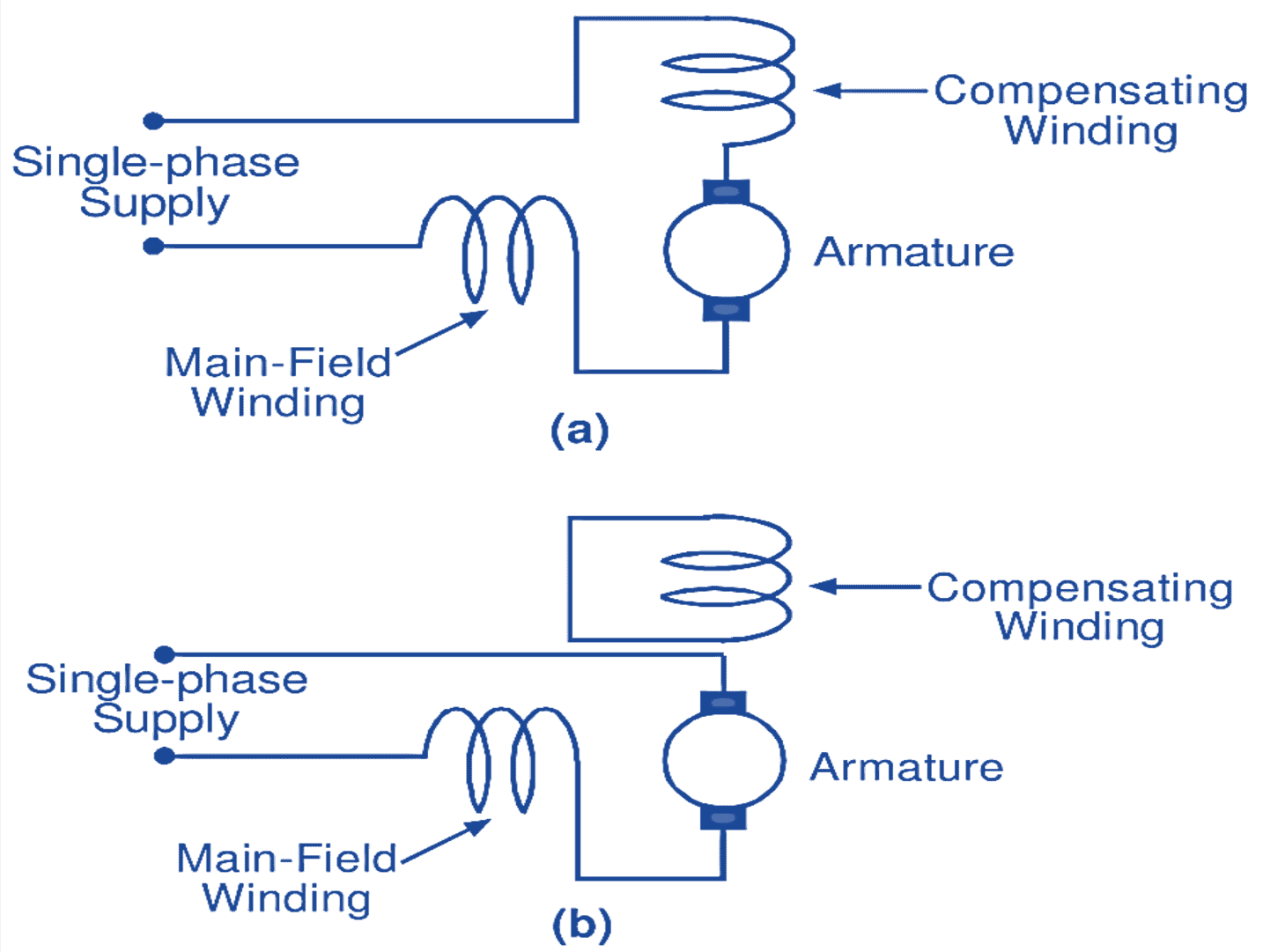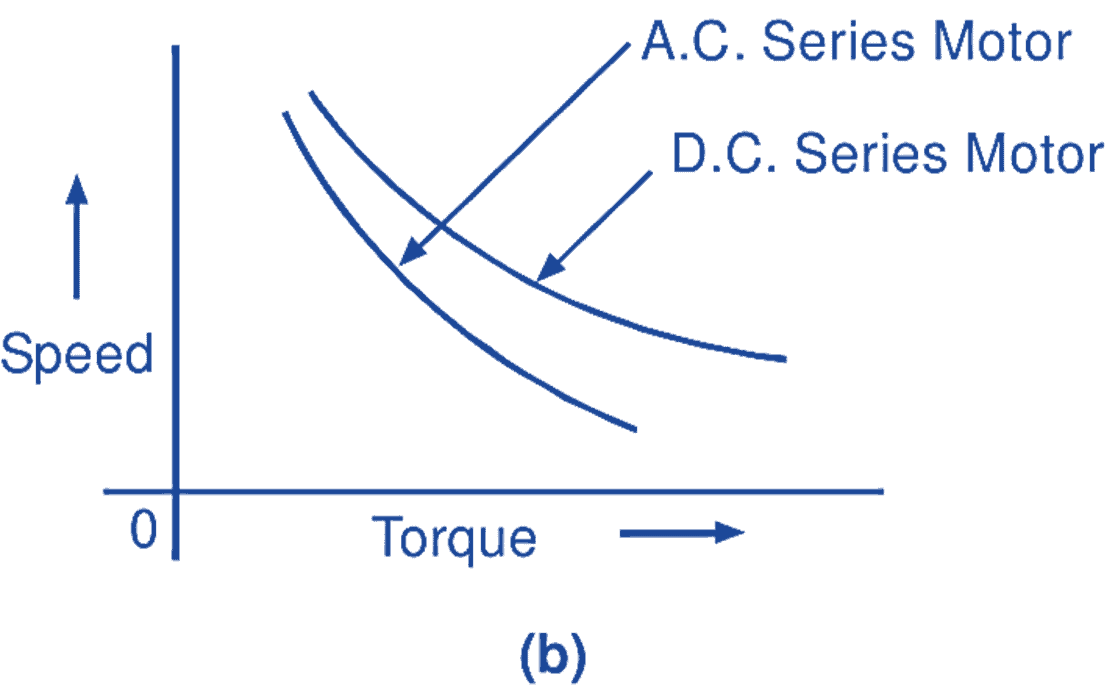In this topic, you study AC Series Motor – Theory, Design, Characteristics, Disadvantages & Applications.
AC Series Motor is a commutator-type motor which is able to work on both dc and single phase ac supply. If an ordinary dc series motor is connected to an ac supply, because of simultaneous reversal of field and armature currents, it will develop a unidirectional torque and as a result of this, its armature will rotate.
Design Considerations for an AC Series Motor
For operating the dc series motor satisfactorily on ac supply, the following modifications in the design are generally incorporated :
(a) Eddy-current loss is minimized by laminating the entire field structure.
(b) The field flux cannot be reduced or neutralized drastically for the purpose of improving the power factor, for its presence is essential to produce the required torque. Still, it is necessary to reduce the reactance of the field winding if the power factor is to be reasonably high. Hence, to reduce the reactance of the field winding, if possible, a low-frequency (as low as $\text{16 }\!\!~\!\!\text{ }\frac{\text{2}}{\text{3}}\text{, 25 Hz}$) supply is used $\text{(}{{\text{X}}_{\text{L}}}\text{= 2 }\text{ }\!\!\pi\!\!\text{ }\text{ f L)}$. Further, inductance of the field winding is also made as low as is practical. For this, the field is wound with fewer turns than an equivalent dc motor $\text{(since L = }{{\text{N}}^{\text{2}}}\text{/S)}$. But this change reduces the field flux for a given current. To some extent, this reduction in flux is compensated by minimizing the reluctance $\left( \text{S} \right)$ of the magnetic circuit $\text{(since }\phi \text{ = m}\text{.m}\text{.f}\text{./S)}$. This is achieved by operating the iron at low flux densities (using increased pole area) and, therefore, at high permeabilities and by using a very short air gap.
(c) In order to obtain the required torque with low field flux, number of armature coils is increased. Naturally, the armature of an ac series motor becomes unusually larger than the corresponding (dc series motor. An increased number of armature coils increases the armature reaction. This creates commutation troubles and results in high armature reactance. To neutralize the increased armature reaction, a compensating winding is embedded in the pole faces. If this compensating winding is connected in series with the armature as shown in Fig. 1 (a), the motor is said to be conductively compensated. For the motors which are to be operated on ac as well as dc supply system, conductive compensation is necessary. If the compensating winding is short-circuited on itself as shown in Fig. 1 (b), the motor is said to be inductively compensated. In this case, the compensating winding acts as a short-circuited secondary of a transformer, the armature being the primary. Hence, ampere-turns of the compensating winding nearly neutralize the ampere-turns of the armature.

Fig. 1: (a) Conductively compensated single-phase ac series motor, (b) Inductively compensated single-phase ac series motor.
(d) E.M.F. induced by transformer action in the short-circuited armature coil undergoing commutation (Fig. 2 a) is reduced by taking following measures:
(i) Preferably single-turn armature coils are used. This necessitates a large number of segments and correspondingly large commutator.


Fig. 2 : (a) Transformer e.m.f. in the armature coil undergoing commutation, (b) Resistance leads to improve commutation.
(ii) Flux per pole is made as small as possible. Hence, for having sufficient flux to develop the required torque, the number of poles is increased.
(iii) Frequency of the supply is reduced. The large short-circuit current caused by transformer e.m.f. in the armature coil undergoing commutation ultimately results into severe sparking at the brushes. This current may be reduced by inserting resistance leads between the armature coils and the commutator segments as illustrated in Fig. 2 (b). However, by providing interpoles (Fig. 3), use of such resistance leads can be completely eliminated.

Fig. 3 : Series motor with interpoles.
Performance Characteristics of an AC Series Motor
The operating characteristics of an ac series motor are similar to those of a dc series motor as illustrated in Figs. 4 (a) and (b). Torque varies nearly as square of the armature current and speed varies inversely as the armature current. The starting torque of an ac series motor is generally 3 to 4 times its full-load torque. The speed of an ac series motor attains dangerously high value on no load or light load. Hence, it is always used with some load on it.


Fig. 4 : (a) Torque versus armature current and speed versus armature current characteristics of ac series motor, (b) Speed-torque characteristics of ac and. dc series motors
Reversal of Rotation of an AC Series Motor
The ac series motor may be reversed by reversing the connections to either the field or the armature winding. When interpoles and series connected compensating winding are used, these should be treated as part of the armature.
Applications of an AC Series Motor
Because of high starting torque, large capacity single-phase ac series motors are commonly employed in traction, hoists and similar other services.
Disadvantages of an AC Series Motor
However, the performance of such a motor when operated on ac supply will not be satisfactory, mainly for the following reasons :
(i) Excessive eddy currents induced in the solid parts like yoke and pole cores due to alternating flux would cause overheating of the motor and a distinct lowering of its efficiency.
(ii) Relatively large reactance of field circuit will reduce the power factor and output to such low values as to make the motor impractical.
(iii) EMF induced by transformer action (called as transformer emf) in the short circuited armature coils during their commutation period would cause vicious sparking at the brushes.